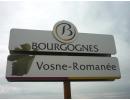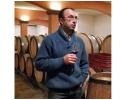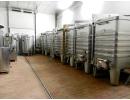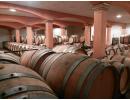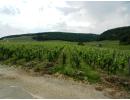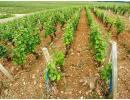Domaine Guyon
Vosne Romanée - Bourgogne
![]() Certified Organic since 2012
Certified Organic since 2012
Clive COATES MW: “This is a property where the vines extend from Chorey-Lès-Beaune to Gevrey-Chambertin, which deserves wider recognition”.
Bettane & Desseauve: "Since a few vintages, this small family estate of 9 ha produces wines of a rare beauty and style, with a philosophy in viticulture and winemaking of an extreme exigency".
Morey Saint Denis "La Bidaude" 2009
Produced from a parcel of 0.24 ha of Chardonnay. A rare white from the appellation planted on clayey-limestone soil towards the top of the slope located just above the famous Clos des Lambrays Grand Cru. The vines average 13 years of age, producing a very low yield of 12 hl/ha, just enough to produce one barrel of 600 litres. Following the sorting the grapes are whole bunch pressed. The fermentation will take 3 - 4 months at cellar temperature in the demi-muid oak barrel. The ageing in the same barrel will last 12 months on fine lees.
Pvins notes: Drink 2012 - 2020
Nuits Saint Georges “Les Argillats” 2009
Produced from a parcel of 0.24 ha of Pinot Blanc. A rare white from the appellation planted on clayey-limestone soil towards the top of the slope. The vines average 13 years of age, producing a very low yield of 13 hl/ha, just enough to produce one barrel of 600 litres. Following the sorting the grapes are whole bunch pressed. The fermentation will take 3 - 4 months at cellar temperature in the demi-muid oak barrel. The ageing in the same barrel will last 12 months on fine lees.
Pvins notes: Drink now
Chorey les Beaune “Les Bons Ores” 2014
Produced from a 1 ha parcel of Pinot Noir averaging 45 years of age producing an average yield of 45 hl/ha. Following the sorting and depending on the vintage about 20% of the grapes are destemmed. A pre-fermentation skin maceration for 4 to 5 days will be carried out. Stainless steel vats are used for the fermentations that will last 25 to 28 days at 27°C - 29°C. The ageing in french oak barrels will last 10 to 14 months with 30% new oak and 70% that are on year old. The wine is then aged a further 3 to 4 months in the vats for the wine to settle and bottled according to the biodynamic lunar calendar. No filtration.
Press: Claude Kolm 87- 91
Both nose and mouth show spicy strawberry fruit. The mouth has excellent concentration and depth with good firmness. This is an excellent wine and one for those looking for top values. Two-thirds of the vines are 80-100 years old. In 2014, yield was 28 hl/ha. Jean-Pierre says this is a wine that can age quite well.
Bettane & Desseauve 14.5
A cellaring Chorey Les Beaune, showing brilliant fruitiness! Drink 2018 - 2022
Nuits Saint Georges “Aux Herbues” 2009
Produced from a 0.22 ha parcel of Pinot Noir averaging 50 years of age producing an average yield of 45 hl/ha planted on marl limestone soil. Following the sorting and depending on the vintage about 20% of the grapes are destemmed. A pre-fermentation skin maceration for 4 to 5 days will be carried out. Stainless steel vats are used for the fermentations that will last 25 to 28 days at 27°C - 29°C. The ageing in french oak barrels will last 10 to 14 months with 30% new oak and 70% that are on year old. The wine is then aged a further 3 to 4 months in the vats for the wine to settle and bottled according to the biodynamic lunar calendar. No filtration.
Pvins notes: Drink 2016 - 2023
Vosne Romanée 2014
Produced from 7 parcels representing 1.05 ha of Pinot Noir averaging 50 years of age producing an average yield of 45 hl/ha and planted on clayey-limestone soil. Following the sorting and depending on the vintage about 20% of the grapes are destemmed. A pre-fermentation skin maceration for 4 to 5 days will be carried out. Stainless steel vats are used for the fermentations that will last 25 to 28 days at 27°C - 29°C. The ageing in french oak barrels will last 10 to 14 months with 30% new oak and 70% that are on year old. The wine is then aged a further 3 to 4 months in the vats for the wine to settle and bottled according to the biodynamic lunar calendar. No filtration.
Press: Wine Advocate 89
The 2014 Vosne-Romanée Village has a delightful bouquet, very pure with red cherry, crushed strawberry and vanilla extract, turning towards dark fruit with aeration courtesy of some blackberry leaf. The palate is medium-bodied with supple tannin, smooth and harmonious in the mouth, the oak tangible but in proportion with the fruit. With fine length and precision, this deserves a round of applause. Drink 2017 - 2030
Bettane & Desseauve 15.5
Complexity and finesse, subtle with a lot of charm. Drink 2018 -2028
Vosne Romanée 1 Cru “Les Brulées” 2014 / 2009
Produced from a 0.15 ha parcel of Pinot Noir averaging 50 years of age producing an average yield of 45 hl/ha planted on marl limestone soil. Following the sorting and depending on the vintage about 20% of the grapes are destemmed. A pre-fermentation skin maceration for 4 to 5 days will be carried out. Stainless steel vats are used for the fermentations that will last 25 to 28 days at 27°C - 29°C. The ageing in french oak barrels will last 10 to 14 months with 1 barrel of new french oak and 2 barrels that are one year old. The wine is then aged a further 3 to 4 months in a vat for the wine to settle and bottled according to the biodynamic lunar calendar. No filtration.
2014
Claude Kolm 90-93
The Brulées is dense and concentrated with a smooth texture, dark fruit, and very good depth. The vines here are 60-70 years old.
Bettane & Desseauve 17
A lot of depth, charm, pleasure, subtlety and refinement with notes of ripe cherries and prunes. Drink 2018 - 2030
2009
Bettane & Desseauve 15
Lots of power, the elegance will come with time. Drink 2019 - 2024
Echézeaux Grand Cru
Produced from a 0.20 ha parcel of Pinot Noir averaging 45 years of age producing an average yield of 40 hl/ha planted on claye-limestone soil. The parcel is situated near the 2 Grands Crus Clos de Vougeot and Musigny. Following the sorting and depending on the vintage about 20% of the grapes are destemmed. A pre-fermentation skin maceration for 4 to 5 days will be carried out. Stainless steel vats are used for the fermentations that will last 25 to 28 days at 27°C - 29°C. The ageing in french oak barrels will last 10 to 14 months with 1 barrel of new french oak and 2 barrels that are one year old. The wine is then aged a further 3 to 4 months in a vat for the wine to settle and bottled according to the biodynamic lunar calendar. No filtration.
Domaine Jean Pierre Guyon is located in Vosne-Romanée on the N74 road to Dijon. In 1991 Jean Pierre and his brother Michel Guyon took over the estate from their father which had been running the estate since 1953. It is their grand-father that started the estate in 1938. The Domaine has grown to 9 ha after purchasing new parcels over the years in both the Côte de Beaune and Côte de Nuits districts. The last acquisition was in 2010 of a new Grand Cru parcel within the Clos de Vougeot. The estate's vineyards stretch from (north to south) Gevrey-Chambertin to Savigny Les Beaune which include four 1er Crus and 2 Grand Crus. Since 2015, Jean Pierre managers the Domaine with his wife Isabelle.
Jean Pierre is passionate and a perfectionist obsessed with quality work in the vineyards and cellar. I recall spending over 3 hours in the cold underground cellar and being captivated by Jean Pierre’s knowledge and love for his work. He humbly said “after 20 years of hard work and trials, I think I might finally be getting it right, eventhough I am still learning”.
Domaine Guyon is certified organic since 2012, but Jean Pierre also uses some bio-dynamic principals such us the moon’s cycle calendar for the work in the vineyards and the timing of the bottling period.
Domaine Guyon's 9 ha spread over both the Côte de Beaune (4 ha) and Côte de Nuits (5ha) districts. Some parcels are only 0.24 hectares or less in size, just enough to make one or 2 barrels depending on the yield and size of the barrel used. The Domaine's various "Village" appellation parcels are located in Gevrey-Chambertin, Vosne Romanée, Nuits Saint Georges, Chorey Les Beaune and Savigny Les Beaune. The 1er Crus parcels are located in Vosne Romanée 1 Cru, Aloxe Corton 1 Cru and Savigny Les Beaune 1 Cru. As for the 2 Grand Crus parcels they are in Echezeaux and Clos de Vougeot.
The grape varieties planted are Pinot Noir, Chardonnay and some Pinot Blanc for the white Nuits Saint Georges. The average of the Pinot Noir vines is 50 years old while the whites are 15 to 40 years old. The Domaine started its organic conversion in 2006 and was certified organic in 2012. But Jean Pierre also uses some bio-dynamic principals such us the lunar calendar for the work in the vineyards and the timing of the bottling. The harvest is hand-picked and green harvesting is also practiced to control the yields and quality of the grapes.
Here are some details about some of the parcels of Domaine Guyon:
Morey Saint Denis "La Bidaude" is a rare white in this appellation, only 3 ha are planted with Chardonnay compare to 132 hectares of Pinot Noir. The 0.20 ha plot is located on the slope just above the Clos des Lambrays Grand Cru at the top of the hill. The terroir is limestone based, ideal for Chardonnay, where the Jurassic limestone mother rock appears on the surface in some spots. The rock brings extra warmth where the Chardonnay can reach full maturity giving the wine a little extra richness.
Chorey les Beaune “Les Bons Ores” is located in the Côte de Beaune area on the right hand side of the N74 road travelling north from Beaune and about 750 metres south-east of the village Aloxe Corton. The Domaine's parcel represents 1 ha in the lieu-dit "Les Bons Ores". The wines are moderately tannic, well-built with elegant tannins and a well-rounded structure.
Nuits Saint Georges “Aux Herbues” is located in the plain at the northern tip of the appellation. The Domaine's plot is 0.22 ha in size. The wines from this area of Nuits Saint Georges have more elegance due to their proximity to Vosne Romanée.
Vosne Romanée this cuvée does not have any specific parcel name as it is a blend of 7 small plots representing 1.05 ha. The vines are planted on clayey-limestone soil in the plains around the village of Vosne Romanée.
Vosne Romanée 1 Cru “Les Brulées” a small plot of 0.15 ha. The climat is surrounded by the Richebourg Grand Cru to the south, “Les Suchots 1 Cru” on the east side and “Les Beaux Mont 1 Cru” to the north. It is one of the top 3 Vosne Romanée 1 Cru climat, the wines are well structured with elegance.
Echézeaux Grand Cru is located to the north of the commune next to 3 other Grands Crus: Clos de Vougeot, Grands Echézeaux and Musigny. The Domaine's parcel, a meer 0.20 ha enough to produce 2 barrels, is located in the lieu-dit “En Orveaux” which is near the Grand Echézeaux Grand Cru and on the edge of the Musigny Grand Cru. The wines from this area have a dense texture and tight tannins in their youth, powerful and virile, they demand to be matched with dishes of the same caliber such us meaty dishes and usually require 4-5 years cellaring.
The white wines produced by Domaine Guyon come from 3 communal appellations: Savigny les Beaune, a rare white from Morey Saint Denis and a rare Pinot Blanc from Nuits Saint Georges. The parcels are minuscule representing only 0.24 hectare each. The yields are very low around 12 hl/ha depending on the vintage, when the average in Burgundy is 45 hl/ha. For the winemaking, the hand-picked harvest is fermented with indigenous yeasts in demi-muid barrels over 3 to 4 months at cellar temperature. The wines are than aged on fine lees in the same demi-muid of 600 litres for 10 to 12 months. The size of the barrel will limit the amount of contact between oak and wine, producing wines with elegant aromas of well integrated oak and flavours.
The whites produced by Domaine Guyon have a wonderful texture and are aromatically complex and long on the palate. As the plots are situated on limestone based terroir with some clay the wines are well-balanced by a natural acidity. They may be cellared for up to 10 years depending on the vintage.
The winemaking process for the reds is the same from communal to Grand Cru appellations. The benefit of this is that you let the terroir express itself through the wine as the work in the vineyard and cellar is the same for all the parcels. The harvest is hand-picked and 3 tris will be carried out to select the best bunches. The first tris will be done in the vineyard at time of picking, the second upon arrival at the cellar and the third on a sorting table before the pressing.
Before the fermentations Jean Pierre will do a skin maceration for 4 - 5 days to extract more colour, aromas and tannins. Also since the mid-2000s, Jean Pierre has been doing some trials of having about 80% of whole bunches during the winemaking process, instead of de-stemming the whole harvest as he did in the past and as often done in Burgundy. The trick is to have the perfect maturity of the grape and stems at the same time. The use of the stems during the winemaking process is to bring structure and some extra freshness to the wine, but you have to be very cautious not to end up with a green, herbaceous and astringent wine. Jean Pierre Guyon is fairly satisfied with the results as he says “every vintage is a new challenge”. The fermentations are carried out in small stainless steel vats for 25 to 28 days at 27°C - 29°C. The wines are aged in the underground cellar in french oak barrels of different sizes depending on the yields produced for each parcel. The ageing will last from 10 to 14 months depending on the wine’s potential and appellation status, also the amount of new oak used will vary as well. After the ageing the wines will be transfered back into stainless steel vats for 3 to 4 months for the wine to rest. The bottling will be carried out according to the biodynamic lunar calendar and when Jean Pierre is satisfied of the wine’s evolution, no filtration is done before bottling.
The reds are dark in colour, aromatically complex with spice and red fruit aromas, the use of stems in the process is not apparent. The wines are deliciously elegant, well-balanced and structured with fine grain tannins. A couple of years of cellaring is recommended, some reds in exceptional vintages may be cellared for up to 20 years.
Links: AOP Vosne Romanée - AOP Echézeaux - AOP Clos de Vougeot - Cote de Nuits map - www.bourgogne-wines.com
VOSNE ROMANEE
The appellation Vosne Romanée was created in 1936. It is located in the Côte de Nuits area of Burgundy and it includes the commune of Flagey-Echézeaux. The appellation spreads over the communes of Vosne Romanée and Flagey-Echézeaux covering 223.60 hectares, of which 57.50 hectares are dedicated to 14 Premiers Crus and 74.60 hectares are covered by 8 Grands Crus which are: Richebourg, Romanée Saint Vivant, La Romanée, La Tâche, La Grande Rue, Echézeaux, Grands Echezeaux and the jewel of Burgundy La Romanée Conti.
History
Records suggest that the village of Vosne has been established since the 6th century. It is impossible to talk about the history of Vosne-Romanée without reference to the Abbey of Saint Vivant, the Croonembourg family and the most famous red Burgundy wine and also appellation of Romanée-Conti. What the abbey didn’t own was mainly in the possession of the Croonembourg family. In 890, the Abbey of Saint-Vivant was built which was to be linked to many of Vosne’s vineyards including those of the village Flagey-Echézeaux. During the 12th century the lands dependant on the village of Flagey-Echézeaux and the village itself came into the possession of the abbey. In 1232, the abbey acquired 1.8 hectares of vineyard that was to become the future Romanée-Conti. In 1631, the parcel was sold to the de Croonembourg family who renamed it "Romanée" and at the same time also acquired the adjacent vineyard of La Tâche. The Croonembourgs than sold the parcel "Romanée" in 1760 to Jean-François Joly who was acting for the Prince de Conti. The parcel was renamed Romanée-Conti in 1764. It was not before 1866 that the name Romanée was attached to Vosne. Today the appellation Vosne Romanée is referred to as the "the pearl of the Côte" due to the high quality of its wines and its numerous high profile Grand Crus.
Vineyard
The vineyards have an easterly exposure at an altitude of 235 to 350 metres with the Grand Crus situated in the middle of the slope. The geological base of Burgundy dates back to the Jurassic era about 130 -150 million years ago. About 60 million years ago, the geological shifts on the earth’s crust from the movement of continents, created the Alps mountain range and made the Bressan rift collapse creating a plain and the Saône ridge on the west side. This led to the creation of a unique landscape with outcrops of different rock layers from different eras. It is the weathering of the region over millions of years that has created Burgundy’s complex terroir. The soils are composed of clay-limestone, marl, limestone and brown clay, producing wines of different organoleptic characteristics. The best terroirs are usually located halfway up the slope in the middle of the ridge where the Grand Crus and Premier Crus are situated. The soils of Vosne Romanée may be described as limestones mixed with clayey marls. The depth of the soil varies from some tens of centimetres to 1 metre in depth.
The Pinot Noir is the only red grape allowed in the appellation, no white wines are produced. The wines from Vosne Romanée have the reputation of expressing the Pinot Noir grape at its heavenly best. The wine’s Characteristicscan be described as follow: Shades of red vary from ruby to black tulip and are often quite intense. Ripe fruit over spices is frequently the main ingredient of the bouquet, with hints of strawberry, raspberry, bilberry, or blackcurrant. These refined and well-blended aromas evolve with age into cherries-in-brandy, preserved fruits, leather, fur and gamey/woodland scents. On the palate the wine is velvety and distinguished but it may sometimes seem a little austere in its youth needing a little time in the cellar.
Throughout Burgundy, the vineyard’s parcels are designated as “Climats”, “Lieu-dit” or “Clos” if they are surrounded by a stone wall. The names were given to precisely delineated plots of land that enjoy specific geological and terroir conditions. The “Climats” have their own unique organoleptic qualities such as their appearance, aromas, flavours, structure and texture. The “Climat” designation is usually used for Premier Cru and Grand Cru parcels while a “lieu-dit” is a name given to a plot. The concept of “Climats” was first mentioned as far back as the 7th century, such as Clos de Bèze a Grand Cru in Gevrey located in the Côte de Nuits area. These specific “Climats” and “lieux-dits” names can be mentioned on the label following the appellation’s name, for example: Vosne Romanée “Aux Réas”, Vosne Romanée 1 Cru "Les Brulées" or Echezeaux Grand Cru “En Orveaux”. By mentioning the name on the label you can identify the exact area in the appellation were the fruit comes from. The Burgundians consider their “Climats” classification of Premier Cru and Grand Cru to be the pinnacle definition of “terroir” as it is the parcels that are classified and not the Domaine, as it is the case for the 1855 Bordeaux classification of 5th Growth to 1st Growth wines.
Climate
The Côte d'Or is on the 47th parallel and the climate is classed as Continental, meaning winters (Dec-Jan-Feb.) can often be very cold with late frosts and summers (Jun-Jul-Aug) curiously like that of Bordeaux can occasionally reach extremely high temperatures. Micro-climates are another significant factor in the region as the heart of the Burgundian vineyards stretch over 50 kilometres from Dijon in the north to Chagny in the south. Most of the vineyards face east or east-south-east, benefiting from the morning sun. The vines are also sheltered by the hills from the wet westerly winds and because of their altitude they are not affected by fog and frost damage that occurs on the plains, but they might still be occasionally covered in snow during winter.



